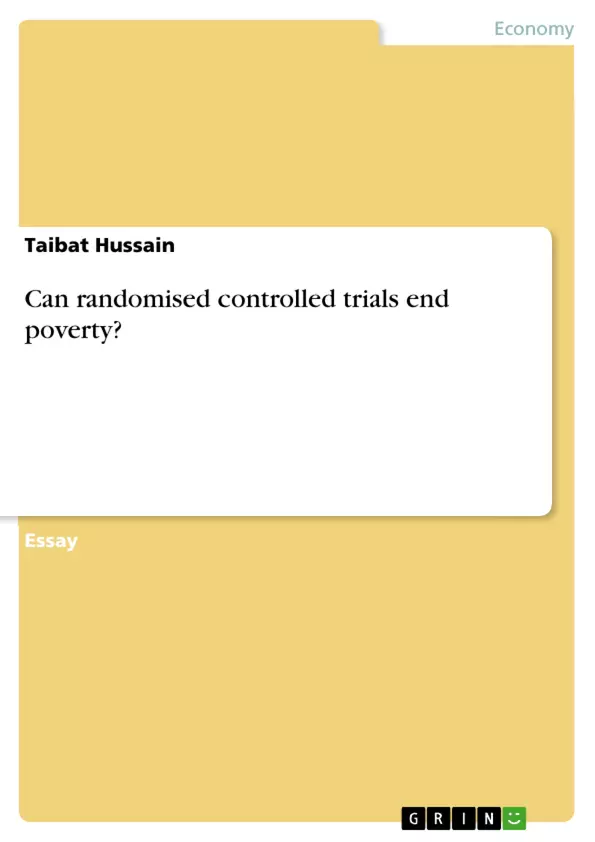This essay provides an overview of randomized controlled trials (RCTs) and their meteoric rise. Then the author discusses key limitations to the use of RCTs, from a theoretical and methodological lens and provides a country-study example.
In recent times, randomized controlled trials (RCTs) as a method of impact evaluation of the effectiveness of development interventions have sparked enthusiasm and optimism among a wide range of stakeholders. Evidence from randomized evaluations is increasingly being used to understand and address poverty-related problems. To that extent, advocates of RCTs labeled the "randomistas" as proffer RCTs the "gold standard" for developing effective poverty reduction policies. Gold standard, in this sense, being the best and most accurate method (without restriction) to designing development interventions and assessing what works and what does not.
Inhaltsverzeichnis (Table of Contents)
- INTRODUCTION
- A NEW WAY OF DOING ECONOMICS: UNDERSTANDING RANDOMISED CONTROLLED TRIALS (RCTS) AND THEIR PROLIFERATION
- HOW DOES RANDOMISATION WORKS?
- PROLIFERATION OF RANDOMISED CONTROLLED TRIALS (RCTS) IN CONTEMPORARY DEVELOPMENT
- ASSESSING RANDOMISED CONTROLLED TRIALS (RCTS): EXPLANATORY LIMITATIONS SURPASS SMALL-SCALE FINDINGS
- CONCEPTUAL PROBLEM
- METHODOLOGICAL SHORTCOMINGS
- SCALING UP WHAT WORKS: A CASE STUDY OF KENYA
- CONCLUSION
Zielsetzung und Themenschwerpunkte (Objectives and Key Themes)
This essay examines the increasing use of randomized controlled trials (RCTs) in development economics, highlighting their potential and limitations. The author explores the historical development of RCTs, their methodology, and their growing popularity in tackling poverty-related issues. The essay aims to shed light on the complexities and challenges associated with applying RCTs in real-world development contexts.
- The rise of Randomized Controlled Trials (RCTs) in development economics.
- The strengths and limitations of RCTs as a research method.
- The ethical and methodological considerations of using RCTs for poverty alleviation.
- The role of context and external validity in interpreting RCT findings.
- The importance of integrating RCTs with other nonexperimental methods.
Zusammenfassung der Kapitel (Chapter Summaries)
- INTRODUCTION: The introductory chapter contextualizes the increasing use of RCTs as a method for evaluating development interventions. It highlights the enthusiasm and optimism surrounding RCTs among various stakeholders, while also acknowledging concerns and criticisms regarding their applicability and limitations.
- A NEW WAY OF DOING ECONOMICS: UNDERSTANDING RANDOMISED CONTROLLED TRIALS (RCTS) AND THEIR PROLIFERATION: This chapter introduces the concept of RCTs as a research method rooted in behavioral economics. It explains the core principles of randomization and the growing popularity of RCTs in contemporary development economics.
- HOW DOES RANDOMISATION WORKS?: This section delves deeper into the methodology of RCTs, explaining how they are designed to isolate the impact of an intervention by comparing treatment and control groups. The chapter highlights the claim of RCT proponents that this method provides an unbiased estimate of the average impacts of a program.
- PROLIFERATION OF RANDOMISED CONTROLLED TRIALS (RCTS) IN CONTEMPORARY DEVELOPMENT: This section explores the factors contributing to the increasing use of RCTs, including their appeal to academics and funders. It also discusses the influence of organizations like J-PAL in promoting the use of RCTs as a primary method for evaluating development programs.
Schlüsselwörter (Keywords)
This essay centers around the concept of Randomized Controlled Trials (RCTs) as a method used in development economics to assess the effectiveness of poverty alleviation programs. Key themes include behavioral economics, external validity, ethical considerations, scaling up interventions, and the integration of RCTs with other non-experimental methods.
- Quote paper
- Taibat Hussain (Author), 2020, Can randomised controlled trials end poverty?, Munich, GRIN Verlag, https://www.grin.com/document/919853



